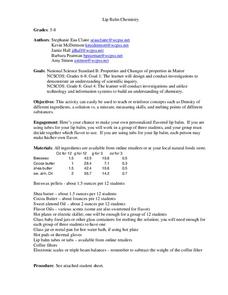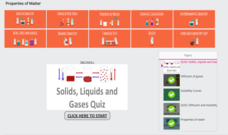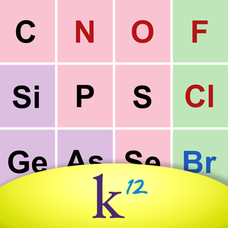National Institute of Open Schooling
Solid State
Crystal comes from a Greek word meaning ice. Activity eight in a series of 36 has class members analyzing amorphous and crystalline solids and further classifying them based on their forces. They then explore solids, learning about unit...
Curated OER
Lip Balm Chemistry
Students explore density, mixture and solutions in a reaction. In this chemistry lesson, students create their own chap-stick using ingredients they analyze for their chemical contents. They discuss measuring skills, melting points and...
Curated OER
Chemical Bonding
Students classify compounds as ionic or covalent. In this chemical bonding lesson plan, students experiment with 6 chemical compounds. They test physical properties such as the melting point, the solubility and the electrical...
Royal Society of Chemistry
Aspirin—The Wonder of Medicine
What do aspirin and the willow tree have in common? Scholars of chemical synthesis engage in a fascinating reaction to make their own aspirin samples. The lab uses thin layer chromatography analysis, includes stoichiometric calculations,...
Curated OER
Solids and Liquids
In this melting points worksheet, students study the melting points table of the solid and liquid states of matter. Students use the table to answer the 7 questions.
Normal Community High School
Golf Ball Lab
The first golf balls were made of wood and would only last for a few games. Modern golf balls last a lot longer but they don't float. The presentation provides the directions for a lab to determine the minimum amount of salt needed to...
Curated OER
Non-Point Source Pollution
Students study non-point source pollution. They research the concept of bio-degradation and/or Nutrients/Fertilizers and discuss how non-point source pollution impacts the environment. Afterwards, they participate in an interactive...
Curated OER
Wet Dry Ice Lab
In this wet dry ice worksheet, students read the information about dry ice and phase change. Students perform an experiment in which they observe phase changes of ice. Students answer analysis questions as it relates to the phase change...
Center for Learning in Action
Water—Changing States (Part 1)
Here is part one of a two-part lesson in which scholars investigate the changing states of water—liquid, solid, and gas. With grand conversation and up to three demonstrations, learners make predictions about what they think will happen...
Center for Learning in Action
Water – Changing States (Part 2)
Here is part two of a two-part lesson plan in which scholars investigate the changing states of water—liquid, solid, and gas—and how energy from heat changes its molecules. With grand conversation, two demonstrations, and one...
CK-12 Foundation
Don't Slip
Salt is the go-to material when people need to melt ice—learn the chemistry behind its effectiveness with an interactive lesson. Pupils watch a short narrative and then explore the concept through a simulation. Young scientists...
CK-12 Foundation
It's Just a Phase
Explore the phases of water as temperature rises. Pupils consider the idea that temperature remains constant during each phase change. An interactive exercise allows your young scientists to observe the temperature and molecular...
Fuse School
Quiz: Solids, Liquids and Gases
Time to show what they know! Module five in a 14-part series about solids, liquids, and gases redirects to an interactive quiz. Learners test their skills on topics such as states of matter, phase changes, and Brownian Motion. With...
Virginia Department of Education
Elements and Electron Configuration
It's electronic! Pupils uncover elements and their electron configurations as they explore mass, groupings, correct charges, and sliding theory. Young scientists learn creative ways to remember various elements and correctly...
Beyond Benign
Enthalpy of Combustion
Learn the facts about types of wax! Partnered pupils determine the enthalpy of combustion for traditional paraffin candles, as well as soy-based candles. The activity focuses on calculations and compares the environmental impact of both...
Royal Society of Chemistry
Alloys
What are alloys, and why do we use them? Through a series of interactive puzzles, scholars examine the components and uses of several common alloys. The accompanying teacher's resources provide support in using the lesson, printable...
Royal Society of Chemistry
Organic Molecules Day—Chemistry Outreach
In search of an organic lab that employs real-life techniques and analysis methods? Groups carry out the nitration of methyl benzoate, then attempt to determine the number and location of the nitro groups added to the benzene ring....
American Chemical Society
Heating Can Make a Change That Cannot Go Back Again
Heat is a gateway to change. While exploring the properties of baking powder, pupils learn that some heat-related changes are permanent. Using an animation, the lesson plan uses chocolate chip cookies as an example.
Curated OER
Periodic Table of Elements
Each of these 111 slides gives the details of one element. The U.S. conventional name, symbol, atomic number and mass, melting point and the boiling point are listed. There are no other details or activities, so this could be used as...
Curated OER
Kitchen Chemistry
Fifth graders examine both physical and chemical changes, and how to identify the difference between the two. They observe the changes that occur in butter when it is exposed to heat and cold, heat energy. In their notebooks, they write...
Curated OER
Is it Ionic?
In this ionic compounds worksheet, students are given clues about compounds such as their physical and chemical properties in order to determine if they are ionic compounds. Students indicate which compounds are ionic and which are not.
Curated OER
The Big Squeeze
Students observe what happens as crayon shavings are melted and/or pressed together. They compare this to the process some rocks go through as they are heated and compressed naturally on earth.
Virginia Department of Education
Molar Heat of Fusion for Water
How can you describe heat of fusion in a way the class understands and relates the importance of this concept to present day issues? In this third lesson of the series, learners conduct an experiment, demonstrating the flow of heat...
K12 Inc.
K12 Periodic Table of the Elements
For anyone learning or teaching chemistry, nothing beats a free and interactive periodic table of the elements. Peruse the elements while learning about atomic number and mass, melting and boiling points, and many other properties of...
Other popular searches
- Boiling Point Melting Point
- Freezing Melting Point
- Melting Point Lab
- Melting Point Pure
- Boiling Point, Melting Point
- Ice Melting Point
- Freezing and Melting Points
- The Melting Point
- Melting Point Pure Mix

























